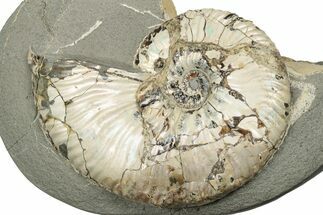This Specimen has been sold.
2.8" Iridescent, Pyritized Ammonite (Quenstedticeras) Fossil Display
This is an interesting and colorful pyritized ammonite (Quenstedticeras sp.) display. The ammonite was collected from the Middle Jurassic age deposits along the banks of the Volga River near Saratov, Russia. It has been mounted to this section of pyrite crystal encrusted rock to create this alluring display.
The rock is a piece of septarian concretion that was collected near Ulyanovsk Oblast, Russia. These concretions occur in clays that have undergone shrinkage, where cracks will appear at the center following dehydration. Septarian concretions often contain calcite, though in some cases they can contain pyrite.
The entire specimen stands 2.8" tall and the base of the rock has been cut flat for presentation.
The rock is a piece of septarian concretion that was collected near Ulyanovsk Oblast, Russia. These concretions occur in clays that have undergone shrinkage, where cracks will appear at the center following dehydration. Septarian concretions often contain calcite, though in some cases they can contain pyrite.
The entire specimen stands 2.8" tall and the base of the rock has been cut flat for presentation.
About Ammonites
Ammonites were ancient marine cephalopods, similar to today's squids and octopuses, but with a defining feature: their distinctive, tightly coiled spiral shells. These shells, resembling those of modern nautiluses, served as both a protective home and a buoyancy aid, allowing ammonites to navigate the prehistoric seas with ease. First emerging around 240 million years ago in the Triassic Period, ammonites thrived for over 175 million years, adapting through numerous forms and sizes. As predatory creatures, they likely fed on smaller marine organisms, using their tentacles to capture prey. However, their long reign came to an end 65 million years ago at the close of the Cretaceous, coinciding with the mass extinction event that also eliminated the dinosaurs.
Ammonites were ancient marine cephalopods, similar to today's squids and octopuses, but with a defining feature: their distinctive, tightly coiled spiral shells. These shells, resembling those of modern nautiluses, served as both a protective home and a buoyancy aid, allowing ammonites to navigate the prehistoric seas with ease. First emerging around 240 million years ago in the Triassic Period, ammonites thrived for over 175 million years, adapting through numerous forms and sizes. As predatory creatures, they likely fed on smaller marine organisms, using their tentacles to capture prey. However, their long reign came to an end 65 million years ago at the close of the Cretaceous, coinciding with the mass extinction event that also eliminated the dinosaurs.
SPECIES
Quenstedticeras sp.
AGE
LOCATION
Saratov, Volga River, Russia.
SIZE
Ammonite: 1.9" wide, Entire specimen: 2.8 x 2"
CATEGORY
SUB CATEGORY
ITEM
#207106
We guarantee the authenticity of all of our specimens.
 Reviews
Reviews













